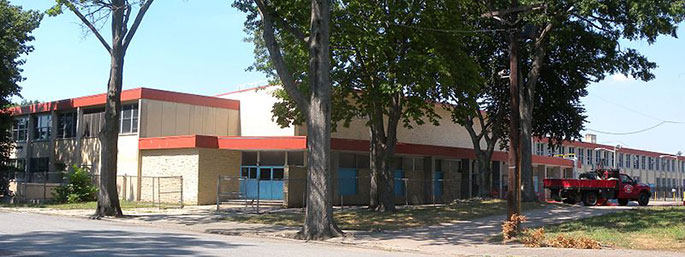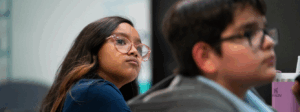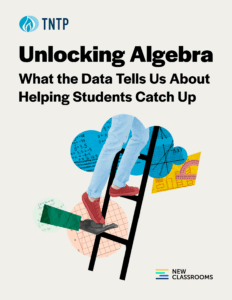Editor’s note: For free resources to help school and system leaders support multilingual learners, download our new resource, More Than Right Answers: Math Instruction for Multilingual Learners.
***
This Multilingual Learner Advocacy Month, we’re reminded that students sitting in classrooms today are the most linguistically and culturally diverse in our nation’s history. All of them deserve challenging, engaging school experiences that set them on a course for social and economic mobility—and no student should have to sacrifice language or culture to get those opportunities.
Those of us at TNTP who have the privilege of serving multilingual students—while also identifying with them linguistically—know that language is our connection to the conversations around the tables in our abuela’s homes, our bond to our cultural heritage, and in many ways, the window to the soul and identities of the students we serve. The two of us grew up speaking Spanish and attended “bilingual” programs in US schools. We were bilingual when we entered a school system that forced us to constantly navigate our two languages and identities. Despite every effort by that system to push us to become monolingual English speakers, both our families ensured that we graduated with our bilingualism and biliteracy.
Unfortunately, subtractive bilingual programs—programs with English proficiency as the goal and little regard for developing proficiency or literacy in the home language; deficit mindsets for languages other than English; and removal of languages other than English from school systems—are still common practices across the country. They persist despite years of research and experience supporting an additive approach—focusing on helping multilingual students add a new language while preserving use of their home language.
The COVID-19 pandemic exacerbated this emphasis on English-dominant resources and heightened inequities between multilingual and native English-speaking students. When schooling was interrupted, emergent bilingual and multilingual students missed out not only on academic content, but on critical opportunities to develop and use all their languages in academic spaces—and on the cognitive growth that comes with those opportunities. As school systems focus on helping students address unfinished learning and accelerate back to grade level, they need to remember that for an emergent bilingual student, learning acceleration is content and language acceleration.
For many school systems, that will require changes to the typical approach to serving multilingual students. Online learning platforms and instructional materials that meet content standards don’t always meet language demands for multilingual learners—and in many cases are not available in languages other than English. Providing curriculum, instruction, and assessment that deny multilingual students the ability to fully demonstrate their knowledge and abilities perpetuates the very inequities learning acceleration is designed to address.
More broadly, too few multilingual students have access to the four resources from The Opportunity Myth and the explicit language instruction they need to address unfinished learning. Instead, many emergent bilingual students languish in schools that push them toward remediation, retention, or social promotion. We’ve personally witnessed so many of these students spending most of their time on work that’s below grade level, in the back of the classroom completing worksheets or working with online programs in English without even the minimum opportunity to access the content their monolingual peers are receiving.
In our efforts to accelerate learning for emergent bilingual and multilingual students, we must explicitly teach and support language development in all its modalities (listening, speaking, reading, writing, and metalanguage). That means we must optimize language learning across all content areas, using language-focused scaffolds to provide integrated language and content instruction. School systems should hold all teachers accountable for promoting academic and language growth for multilingual students in all subject areas.
TNTP’s Learning Acceleration for All guide called out active inclusion of multilingual learners and their caregivers as a key component of any learning acceleration strategy, and recommended examining data for disparities in engagement to ensure multilingual learners and their families are full partners in their education. This is a critical baseline step for addressing inequities. But systems need to go even further to fully tap into the benefits of multilingualism. Offering linguistically and culturally responsive educational spaces with high-quality, biliterate instructional materials as part of learning acceleration efforts can help all students achieve their fullest potential. Below, we offer several action steps to help school and system leaders make that a reality for the students they serve.
- Know the language allocation plan. Review your school system’s language model/plan for meeting the needs of multilingual students, emergent bilingual students, and English Learners. Is it meeting the needs of students? Is it additive and affirming of the languages and knowledge in your community? How does the language plan align to the district’s strategic plan or vision.
- Elevate multilingual students’ home languages. Linguistic equity means intentionally elevating and celebrating multilingual students’ home languages in the classroom and across the school community. How can you create access to information, content, and resources in multiple languages for the school community, including caregivers and non-professional staff?
- Teach for biliteracy in bilingual programs. Bilingual or dual language programs exist to promote biliteracy—literacy in two languages. Teach foundational skills with research-based instructional practices and support, with equitable resources relative to English literacy efforts. What are the language goals for the program model, and what are the current outcomes? Do stakeholders know that the goal of our model is for students to be biliterate? How can we align instructional practices, instructional materials, and resources to support biliterate students?
- Define or refine language instruction practices. Language practices and supports should be a focus in all subjects and for all teachers. This includes familiarity with practices that allow students to mobilize their full linguistic repertoire in service of mastering content. How is your school system providing explicit language instruction to support content? How are you providing linguistic support alongside curriculum, instruction, and assessment across all disciplines?
- Engage students in cross-linguistic work via metalinguistic awareness. Provide opportunities and modeling for students to reflect on how they think about languages. Create a culture where students can use all their languages in academic spaces and make critical connections between their languages to support content learning and identity. How can you give multilingual learners the identity as linguistically accelerated students?






